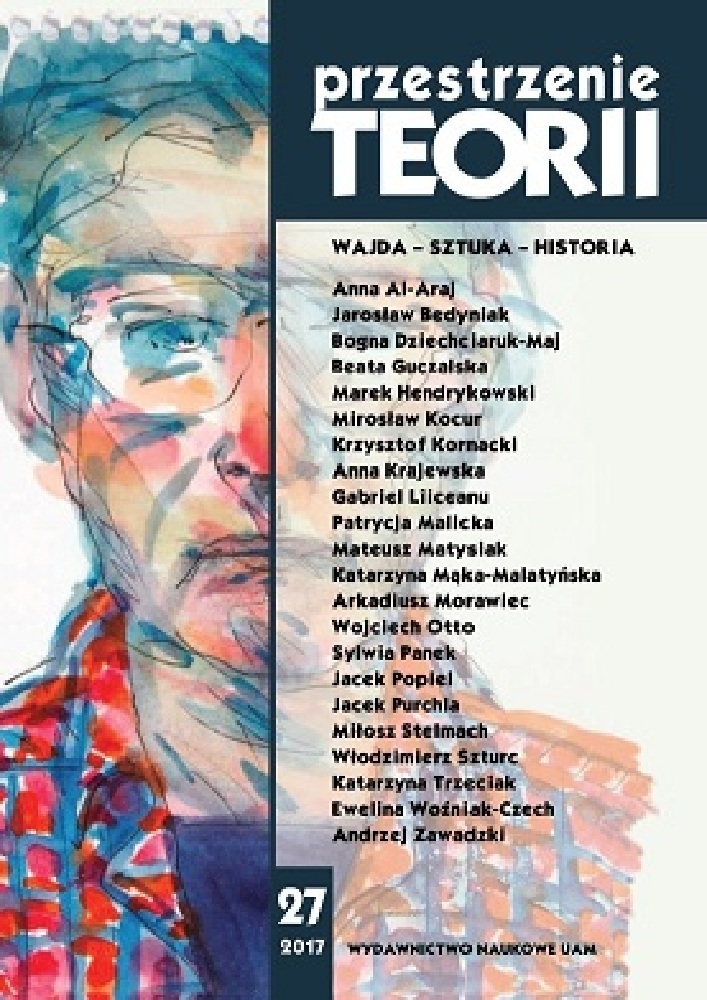Abstrakt
Observing the process of the birth of Man of Marble – Man of Iron – Wałęsa. Man of Hope trilogy we can clearly see the author’s increasing tendency to render movie fiction real, in the sense that fiction should be treated as reality, as its equivalent. In the two first films in the trilogy, what is visible is the intensified blurring of the lines between fiction and reality, substituting what is fact with something concocted. What we can also see here is a tendency to boost the credibility of a fictional story, thanks to the use of conventions and documentary materials. Gradual changes made in the sphere of art were connected with the director’s public activities, in which he gradually crossed the boundaries not only of social, but also political praxis. Moreover, in creating the trilogy we can see a voluntaristic trend to perceive the past as the history of “great men” and to canonize the glorious image of history. All these tendencies were expressed in the latter work. Wajda completed this as a clear response to political moves by certain politicians and historians attacking Wałęsa. Preparing a movie about him, he approached verification of historical data with a single-minded attitude. Thus in this film we can observe “true fabrications”. Wałęsa pervades the story, and there is no room for other important figures in the historical process. Additionally, in order to create an imagined, idealistic image of Wałęsa (“Wałęsa 2.0”), the actor playing this role “expels him” from the archive material.
Bibliografia
Bądźmy dobrej myśli. Z Andrzejem Wajdą rozmawia Krystyna Nastulanka, „Polityka” 1981, nr 22.
Głowacki J., Przyszłem, czyli jak pisałem scenariusz o Lechu Wałęsie dla Andrzeja Wajdy, Warszawa 2013.
Kornacki K., Powroty Wajdy. „Popiół i diament” w filmach reżysera po 1989 roku, „Pleograf” 2006 nr 1, <http://akademiapolskiegofilmu.pl/pl/historia-polskiego-filmu/pleograf/andrzej-wajda/1/powroty-wajdy-popiol-i-diament-w-filmachrezysera-po-1989-roku/535> (dostęp: 15.12.2016).
Lubelski T., Wajda, Wrocław 2006.
Marszałek R., Filmowa pop-historia, Kraków–Wrocław 1984.
Marszałek R., Moje kino. Popiół i diament. Wątek odnaleziony, „Kino” 1998., nr 12, s. 16–17.
Michałek B., Jak powstawał „Człowiek z żelaza”, „Kwartalnik Filmowy” 1996, nr 15–16, s. 47–82.
Nie tracąc nadziei. Z Andrzejem Wajdą rozmawia Tadeusz Lubelski, „Kino” 2013, nr 10, s. 12–15.
Odcyfrowałem Wałęsę. Z Andrzejem Wajdą rozmawia Agnieszka Kublik, <http://wyborcza.pl/1,76842,10863646,Andrzej_Wajda__Odcyfrowalem_Walese.html> (dostęp: 15.12.2016).
Przylipiak M., Refleksja nad dokumentalizmem w filmach fabularnych Andrzeja Wajdy, [w:] Kino polskie: reinterpretacje. Historia – ideologia -polityka, red. K. Klejsa, E. Nurczyńska-Fidelska, Kraków 2008, s. 97–118.
Sztuka splotła się z życiem [wypowiedź A. Wajdy], „Przekrój” 1981, 1.03, s. 16.
Wajda A., Moje notatki z historii, „Kwartalnik Filmowy” 1996, nr 15–16, s. 7–21.
Wajda A., Moje spotkania z historią, „Film na Świecie” 1991, nr 4 (383), s. 70–76.
Wajda: filmy, red. J. Słodowska, Warszawa 1996, t. 2.
Witek P., Andrzej Wajda jako historyk. Metodologiczne studium z historii wizualnej, Lublin 2016.
Zawistowski A., Jak rzeźbiono „Człowieka z marmuru”, „Biuletyn Instytutu Pamięci Narodowej” 2010, nr 3, s. 63–6
Licencja
Autorzy
Autorzy tekstów przyjętych do publikacji w czasopiśmie „Przestrzeniach Teorii” są zobowiązani do wypełnienia, podpisania i odesłania na adres redakcji umowy o udzielenie nieodpłatnej licencji do utworów, z zobowiązaniem do udzielania sublicencji CC.
Zgodnie z umową, autorzy tekstów opublikowanych w czasopiśmie „Przestrzeniach Teorii” udzielają Uniwersytetowi im. Adama Mickiewicza w Poznaniu niewyłącznej i nieodpłatnej licencji oraz zezwalą na użycie sublicencji Creative Commons Attribution-NonCommercial-NoDerivatives 4.0 International (CC BY-NC-ND 4.0).
Autorzy zachowują prawa do dalszego, swobodnego rozporządzania utworem.
Autorzy, którzy wykorzystują w swoim tekście cudze utwory (np. ilustracje, fotografie) proszeni są o dostarczenie do redakcji czasopisma zgodę na publikację od uprawnionych podmiotów.
Użytkownicy
Zainteresowani użytkownicy internetu uprawnieni są do korzystania z utworów opublikowanych po 2015 roku „Przestrzeniach Teorii” tylko w calach niekomercyjnych, pod następującymi warunkami:
- uznanie autorstwa - obowiązek podania wraz z rozpowszechnionym utworem, informacji, o autorstwie, tytule, źródle (odnośniki do oryginalnego utworu, DOI) oraz samej licencji;
- bez tworzenia utworów zależnych - utwór musi być zachowany w oryginalnej postaci, nie można bez zgody twórcy rozpowszechniać np. tłumaczeń, opracowań.
Do wszystkich tekstów opublikowanych przed 2015 r. prawa autorskie są zastrzeżone.
Inne
Uniwersytet im. Adama Mickiewicza w Poznaniu zachowuje prawo do czasopisma jako całości (układ, forma graficzna, tytuł, projekt okładki, logo itp.).
